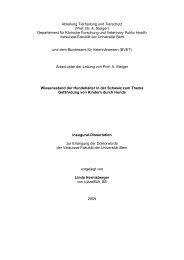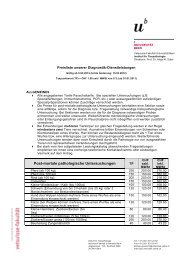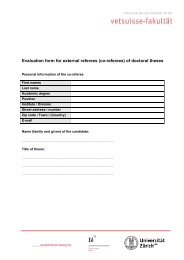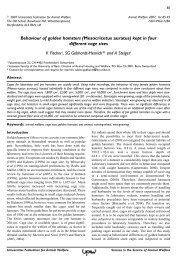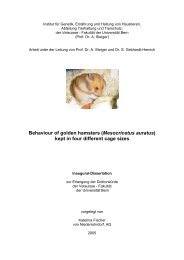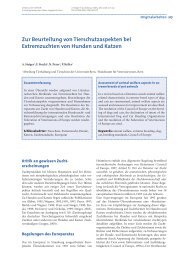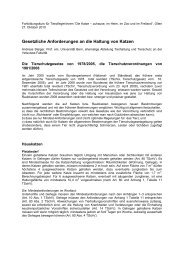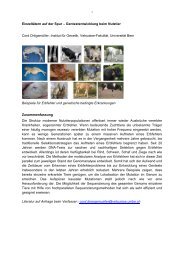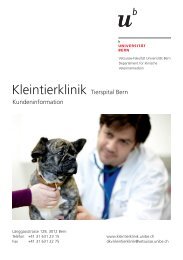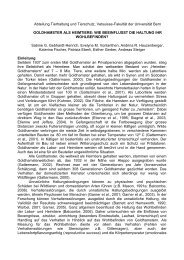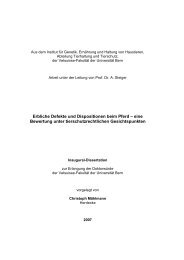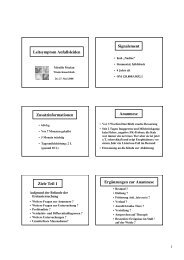Radiographic findings in several joints of nine bears
Radiographic findings in several joints of nine bears
Radiographic findings in several joints of nine bears
Create successful ePaper yourself
Turn your PDF publications into a flip-book with our unique Google optimized e-Paper software.
efficacy and disappearance <strong>of</strong> symptoms dur<strong>in</strong>g treatment. The result <strong>of</strong> the zoo veter<strong>in</strong>arian<br />
with the highest evaluation as well as <strong>of</strong> the zoo veter<strong>in</strong>arian with the lowest evaluation <strong>of</strong><br />
pa<strong>in</strong>, quality <strong>of</strong> life and discomfort was used to calculate the mean for each animal. M<strong>in</strong>us<br />
five po<strong>in</strong>ts were allocated to the part “additional assessment”, and plus 15 po<strong>in</strong>ts to the part<br />
“radiographic exam<strong>in</strong>ation”. A mean was calculated for each animal. On this basis, treatment<br />
can be recommended when the obta<strong>in</strong>ed result lies between one to 30 po<strong>in</strong>ts for result without<br />
additional exam<strong>in</strong>ation, and between one to 45 po<strong>in</strong>ts with additional exam<strong>in</strong>ation. The<br />
prognosis is considered to be doubtful when the result lies between 31 to 51 or 46 to 66,<br />
respectively. Euthanasia should be considered with a score over 51 or 66, respectively.<br />
Discussion<br />
The aim <strong>of</strong> this study was to develop a systematic approach to def<strong>in</strong><strong>in</strong>g the appropriate time to<br />
euthanize a geriatric zoo mammal. For this purpose, we studied retrospective and prospective<br />
cases from five different European zoos <strong>in</strong> order to evaluate a correlation between symptoms<br />
and pathologic <strong>f<strong>in</strong>d<strong>in</strong>gs</strong>. Additionally, 28 veter<strong>in</strong>arians evaluated pa<strong>in</strong>, discomfort and quality<br />
<strong>of</strong> life <strong>of</strong> these animals. Comb<strong>in</strong><strong>in</strong>g these results the study presents a scor<strong>in</strong>g procedure to<br />
allow the zoo veter<strong>in</strong>arian to evaluate the general condition <strong>of</strong> an old animal and if necessary<br />
to support the decision for euthanasia.<br />
In the geriatric zoo mammals, similar symptoms were described <strong>in</strong>dependently <strong>of</strong> the<br />
zoo and <strong>of</strong> the species. Of the five predom<strong>in</strong>ant cl<strong>in</strong>ical symptoms, vomit<strong>in</strong>g, anorexia and<br />
apathy were significantly associated with neoplasia whereas lameness, pa<strong>in</strong> when stand<strong>in</strong>g up<br />
and anorexia were significantly associated with “dysfunction <strong>of</strong> the musculoskeletal system”.<br />
These five symptoms were very frequent. Neoplasia was diagnosed <strong>in</strong> 26.2% <strong>of</strong> all exam<strong>in</strong>ed<br />
animals, but if we consider only the species from which life expectancy <strong>in</strong> the wild is known,<br />
this value reached 37.9% (with an age equal or superior to 100% <strong>of</strong> the life expectancy <strong>in</strong> the<br />
wild). Dysfunction <strong>of</strong> the musculoskeletal system was recorded <strong>in</strong> 36.9% <strong>of</strong> all exam<strong>in</strong>ed<br />
animals, but <strong>in</strong> 41.4% consider<strong>in</strong>g only species with known maximal age <strong>in</strong> the wild , and<br />
other diseases were diagnosed <strong>in</strong> 36.9% <strong>of</strong> all exam<strong>in</strong>ed animals, but this value dim<strong>in</strong>ished to<br />
20.7% consider<strong>in</strong>g only species with known maximal age <strong>in</strong> the wild. The groups neoplasia<br />
and dysfunction <strong>of</strong> the musculoskeletal system represented 63.1% <strong>of</strong> all animals <strong>in</strong> this study,<br />
but this value reached 79.3% consider<strong>in</strong>g only species with known maximal age <strong>in</strong> the wild.<br />
As far as neoplasia is concerned, it is known that age has an <strong>in</strong>fluence on the risk <strong>of</strong><br />
develop<strong>in</strong>g neoplasia (Kennedy & Strafuss 1976; Port et al 1981; Gage 1999; de Magalhaes &<br />
Toussa<strong>in</strong>t 2002; Nimmervoll et al 2005). The present study showed that an animal with<br />
symptoms and with an age equal and superior to 100% <strong>of</strong> the maximal age reached <strong>in</strong> wild<br />
animals had a probability <strong>of</strong> 33.3 % to develop neoplasia. In addition, tumors were either<br />
malignant (82.3%, n = 14/17) and / or surgery was impossible due to their localization<br />
(recurr<strong>in</strong>g leiomyoma <strong>of</strong> the cervix, chondroma <strong>of</strong> thoracic vertebra).<br />
Old animals are <strong>of</strong>ten affected with dysfunctions <strong>of</strong> the musculoskeletal system (Jack<br />
& Thacker 1985; George et al 1990; Canfield & Spencer 1993; Kompanje & Klaver 1998;<br />
Kompanje et al 2000; Colman & B<strong>in</strong>kley 2002; Erw<strong>in</strong> et al 2002; Morbeck et al 2002;<br />
Nichols & Zihlman 2002; Kitchener et al 2003, Kitchener 2004). Degenerative skeletal<br />
lesions represent a major portion <strong>of</strong> old zoo mammal pathologies. In a study <strong>in</strong>volv<strong>in</strong>g 27 bear<br />
skeletons <strong>of</strong> different bear species that were about 15 years <strong>of</strong> age, 96% had evidence <strong>of</strong><br />
skeletal pathologies (Kitchener 2004). Lions (Panthera leo), tigers (Panthera tigris), gorillas<br />
(Gorilla gorilla), orangutans (Pongo pygmeus), babirusas (Babyrousa babyrussa) and pygmy<br />
hippos (Hexaprotodon liberiensis) suffer from similar problems as <strong>bears</strong>, but with vary<strong>in</strong>g<br />
degrees (Kitchener 2004). The pathological alterations were considered significant and <strong>in</strong><br />
human terms these would be regarded as very pa<strong>in</strong>ful (Kitchener 2003; Gregory 2004). In the<br />
present study, animals suffer<strong>in</strong>g from arthrosis and / or spondylarthropathy represent 66.7%<br />
(n = 16/24) <strong>of</strong> all animals with dysfunction <strong>of</strong> the musculoskeletal system. Lameness and<br />
24



